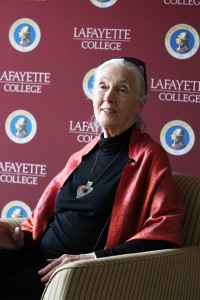“Making a Difference”
April 11, 2013
“The most important message to get across to people is that every single one of us has an impact almost every single day.”
Dame Jane Goodall (born Valerie Jane Morris-Goodall) was born in London, England on April 3, 1934. At the time she spoke at Lafayette College, she has reached her 79th full year of life. Her childhood was full of adventures and animals, as her stuffed chimpanzee toy Jubilee has been widely publicized as early evidence of Jane’s love of animals.
After saving up enough money in 1957 to travel with a schoolfriend to Kenya, her longtime passion of Africa continued. She took a friend’s piece of advice and phoned renowned Kenyan archaeologist Louis Leakey to talk about job opportunities in Africa involving animals. Dr. Leakey, looking for someone to research chimpanzees to elucide their connections with the human species, hired Goodall as a secretary. Once he saw her skill and enthusiasm, she said in her speech on April 11, he knew she was the research assistant he was looking for. After obtaining his wife’s permission apparently, Jane flew to Tanzania to meet face to face with Dr. Leakey. He then sent her to London in 1958 to study primate behavior and anatomy. In 1960, she flew with her required chaperone (for the first 6 months), her loving and supportive mother, to Gombe National Park in what is now known as Tanzania to study the Kasekela chimpanzee population. At the time, the country was known as Tanganyika and was a British protectorate.
She had funding for a year, and while her mother wasn’t there long enough, Jane established a connection with the chimpanzees before the end of that year, who she named and got to know. To become more fully educated in animal behavior/ethology, Dr. Leakey continued to raise funds for Goodall to attend Cambridge University, where she became the eighth and to date among only a handful of individuals to obtain a Ph.D. without first receiving a bachelor’s degree or its equivalent. According to the now Dr. Goodall, she did not initially wish to obtain her doctorate, because it would take her away from one of her favorite places on Earth and from her favorite creatures. However, Dr. Leakey wanted Goodall to be accepted by fellow members of the general scientific and animal behavior communities. She completed her doctorate degree in 1965 with her thesis about her first five years in Gombe National Park. It was entitled, “Behavior of the Free-Ranging Chimpanzee”.
Since 1960, Dr. Goodall had studied chimpanzees extensively in Gombe National Park. In 1977, she started the Jane Goodall Institute (JGI), which began as a means to raise funds as well as awareness about chimpanzee research and their immense value. Today, the JGI is a vocal advocate for conservation and development projects in African communities. For example, the JGI has established microloan systems specifically having women be the beneficiaries. Turning even more to activism, JGI and Jane Goodall started a global youth program called “Roots and Shoots” in 1991 which aims to involve and engage children to care about the precious environment around them. Her message is ultimately one of optimism: one can do everything he or she can to save and conserve the environment and its valuable resources.
Dr. Goodall has written about 11 books including 2 autobiographies, with topics ranging from the environment to animals to conservation to botany. She is now a full time activist for animal rights and environment conservation. She has a grueling traveling/speaking schedule which she completes admirably and with visible serenity.
Three Takeaway Points for INDS211:
1. Jane Goodall came into the field of animal behavior after a lifelong affinity which she has described at length. Her mother was supportive and understanding of Jane’s goal, and Jane credits her “incredible” mother as the foundation of her motivation. Her connection with Dr. Louis Leakey allowed her to launch her longheld position as a chimpanzee researcher and ethologist.
2. Her next steps seem to involve activism rather than continued field work. Her next book, Seeds of Hope, about botany and its prominent role in the world, is due out soon following some revisions. She continues to be active in the JGI and Roots and Shoots. Preceding her evening lecture on April 11, Dr. Goodall seemed to mostly enjoy talking to young children, urging them to “follow their dreams” to save the environment and ultimately the world.
3. Advice that Jane Goodall would most likely give to undergraduates is one of, obviously, hope. There are many people in her specialized position who would paint the world as a daunting place where all positive efforts fail. Dr Goodall, on the other hand, requests that students think about the positive change that can come from their untiring work. Whatever students choose to do, as long as it furthers the Earth’s conservation of natural resources and irreplaceable species, they should be fully immersed in their line of work or profession.

Leave a Reply